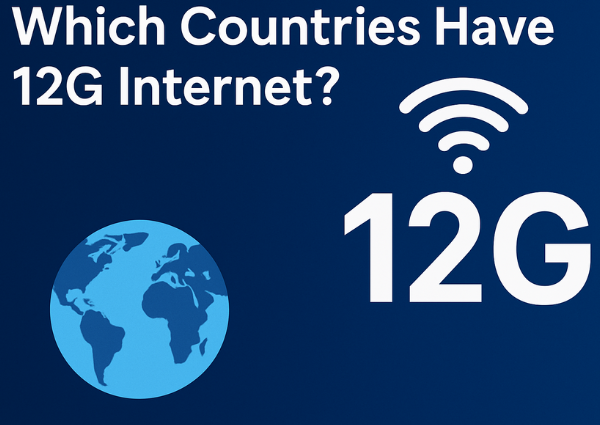Which countries have “12G internet”?
Many people ask “Which countries have 12G internet?” — the short answer: none. “12G” is not a mobile-generation standard for public cellular networks. This 1,500-word SEO article explains what people mean by “12G,” the difference between data-plan sizes (12 GB), video standards called 12G-SDI, the current mobile generations (up to 5G/5G-Advanced), and the realistic timeline for next-generation networks like 6G.
Why this question keeps popping up?
If you landed here searching “Which countries have 12G internet?”, you’re not alone — the term circulates in forums, social media posts and comments where people mix up gigabytes, video interface jargon, and cellular generation names. This guide clears up the confusion, explains what currently exists (5G and ongoing 6G research), and gives actionable SEO-friendly content you can use on a blog or site.
Short answer: No country currently offers a commercial mobile “12G” network — there is no recognized mobile generation called 12G. Instead you might be seeing references to 12 GB data plans or 12G-SDI (a professional video interface), neither of which are the same as a cellular “generation.”
What people commonly mean by “12G” (and why those meanings are different)
When someone types “12G internet” they usually mean one of three things:
-
“12 GB” (gigabytes) data plan — a monthly mobile data allowance sold by carriers (e.g., “Is 12 GB enough?”). That’s a quantity of data, not a generation of wireless technology.
-
12G-SDI (12-gigabit Serial Digital Interface) — a broadcast/video standard (≈11.88 Gbps) used in professional 4K/60 production and studio links; this is unrelated to cellular mobile networks. If you see “12G” in camera, switcher, or broadcast contexts, it’s almost always 12G-SDI.
-
A mistaken belief that wireless has progressed past 5G to a named “12G” generation — this is incorrect. Cellular generations are named sequentially (1G, 2G, 3G, 4G, 5G) and industry work is now focused on 6G research and eventual standardization — not any “12G.”
Because of these distinct uses, it’s important to use precise language: “GB” (gigabytes) for data allowances, “12G-SDI” for video links, and “G” as shorthand for a mobile network generation (1G–5G–6G).
The real state of mobile networks today (as of 2025)
-
5G and 5G-Advanced are the commercially deployed mobile generations across dozens of countries worldwide. There are many lists tracking 5G rollouts and which countries/cities have commercial 5G.
-
6G is an active area of research, with industry labs, vendors and national projects running trials and pilot projects. Experts and vendors expect pre-commercial trials in the late 2020s and target commercial 6G services around 2030, but full standardization and wide deployment will take years. There is no 12G mobile standard on the roadmap.
So, if your audience expects a list of countries “with 12G,” it’s better to correct the misunderstanding and offer up-to-date context about 5G coverage and 6G timelines.
Why “12G” as a mobile generation is implausible (quick technical reasoning)
Mobile generations have historically required global standardization, years of specification work (3GPP/ITU), spectrum allocation, and new chipset and radio ecosystems. Jumping from 5G to something labeled “12G” would imply skipping multiple established generational steps (6G–11G) — something the standards and telecom community don’t do. Instead, the industry iterates (5G → 5G-Advanced → 6G research → 6G standards). For credible forecasts and status updates, consult organizations like Ericsson, GSA and 3GPP.
If you meant “Which countries have 12 GB plans?”
If your search really meant “Which countries offer mobile plans with 12 GB of data?”, that’s a carrier-level question (not a network generation). Nearly every country has at least one mobile operator offering plans around 10–15 GB; availability, price and speed vary widely. For up-to-date price comparisons, use local carrier sites or aggregator tools — and use the keyword variations “12 GB mobile plan,” “12 GB data plan [country name],” and “monthly 12GB SIM” in your SEO content.
If you meant “12G-SDI” (broadcast) — who uses it and where?
12G-SDI is a standardized video interface used by broadcast studios and production houses to carry 4K60 video over a single coax or fiber link. It’s global — used in professional installations, OB vans, stadiums and studios — but it’s a video-equipment standard, not an internet or cellular standard. If your audience is in TV production, include keywords like “12G-SDI cable,” “4K60 single-link,” and “SMPTE ST 2082” in your content.
FAQ
Q: Do any countries have 12G mobile internet?
A: No. There is no recognized generation called “12G.” Current commercial cellular networks are 4G and 5G; 6G research is underway with an expected commercialization target near 2030.
Q: What is 12G-SDI?
A: 12G-SDI is a professional video standard (about 11.88 Gbps) used to carry 4K video over a single link in broadcast and production environments — not a cellular network.
Q: Do carriers sell 12 GB plans?
A: Yes — “12 GB” describes a data allowance on a plan. Many operators worldwide offer plans in that size; check local carriers for prices and coverage.
